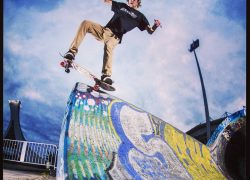Wow there is so many people writing so many good articles, I’m going to be out of a content writers job soon. Anyway as written by just_bring_it_uk, a little look into the world and history of the skateboarding truck.
Trucks
It doesn't matter how into skateboarding you are; unless you have a specular brain and to much time on your hands, you're going to take the easy approach and ride whatever trucks feel good without understanding much besides the width and height, the two most basic and visible traits. My skate Buddy's and I have a few collective years of skateboarding experience between us, and I have asked around, curious as to how many of them had a deep understanding of the factors that contribute to making trucks react.
I calculated an exact measurement of our truck comprehension, Zero.
I had to talk to the only skater I know who rips and is smart enough to not only understand exactly what makes a truck turn.
In the person I was just talking about patiently explained every interconnected variable, but my notes slurred into unreadable loops and squiggles when I fell asleep halfway through. Luckily, knowing the square root of pi isn't required to discover which trucks are the right ones for you. When setting up a complete skateboard, especially if its one of your first rides, just remember that’s all the components combined create a single unified feeling. Trucks are designed to work together, so don't mix up brands and sizes because they look cool or your bro busted an axle and wants to unload a single truck on you.
History of trucks
Skateboard trucks began as roller skates ripped in half and nailed to a plank of wood. According to legend, this was going on as far back as the 1940s. As skating grew into its own activity rather than offshoot of surfing during the mid 70s its popularity blew up. All sorts of funky and gross truck designs flooded the market. No longer merely roller skate component's inventors focused on skaters needs like increased width and wider turning radius. Companies went nuts with innovations with chaos ensuring. It was like a riot of truck designs each one trying to solve the various problems while remaining strong length to not to break. There was no universal standard, and every other month a new company declared they'd created the ultimate turning system for skateboards. It was so haywire that most board companies in the 70’s didn't pre drill their decks because nobody knew what kind of trucks a skater would use. Some truck companies had three hole patterns while others had four and another company would have its holes spaced differently. Skating faded to the most embarrassing fad for most America by the early 80s. If you skated, you were considered a loser that was so out of touch with what was cool that you couldn't recognize BMX was the new thing. But at least a few skaters who kept shredding finally found a standardized truck system. Small tweaks to material and design constantly occurred but never anything too drastic. That lasted nearly a decade until low profile trucks came along.
Its strange to recall that in the dusty days of yesteryear, around the mid-80s, there were basically two options for trucks, independent and tracker (Gullwing was also able but had a small market share). The common argument was that Indys turned and trackers didn't. Whatever, The point is it was pretty damn simple to choose trucks. You picked one brand one colour, and bought the size that fits your deck. Then you rode them until you grounded down your axle, unless you rode copers, the plastic covers that helped you grind but now seem sort of embarrassing.
Slowly, as the 80s progressed, so did marketing and truck Tec. Street skating evolved from mixing vert skating and freestyle {flatland skating on a smaller board}. Street skaters cribbed tricks from freestyle and injected them with steroids, and this new harsher skating created a demand for different trucks than what vert skaters rode. Until this point, trucks were basically designed for skating transitions, whether big {empty pool} or small {sidewalk bump}.
Freestyle trucks were basically miniature trucks, far two small for street shredders. Truck manufactures quickly began tweaking their designs to meet the changing design of street skating. The new skaters wanted to be closer to the ground for improved control, which allowed them to manipulate their boards better. And they wanted their set-up to be as light as possible. Vert skaters needed larger wheels for speed, but street skaters were more concerned with pinpoint accuracy smaller wheels provided. High trucks felt wobblier, and the low profile truck design was seen as a gift from the truck gods bestowed on worthy street rippers. Today almost every brand makes them, and some even offer three height levels.
Force
Through its important to understand why your deck reacts the way it does, being a Tec tard does not really matter. Adjusting your trucks is similar to Luke Skywalker using the force in Star wars to blow up the death star. If you ever watch a pro set-up a new board, you will understand the compassion. The skater stands on his/her board and seems to focus internally as he/she rocks back and forth. Then the skater will make an adjustment. Tighten or loosen the trucks, and get back on the board. He/she repeats the process until it feels right. There is no measuring, no counting turns, no calculating. When you’re starting out, you might want to tighten your trucks more than the average rider, whatever brand you choose, because that will give you a more stable feeling. But once you get comfortable and your style and type develops, you will likely want to adjust your trucks accordingly. Do you want a smooth, flowing feeling, as if carving a wide-open pool wall? Do you want the opposite? After blasting down a triple set, you might want to go as straight as possible. Nobody can tell you what truck is prefect for you without first understanding how to skate. Open a skate magazine and checkout the countless rippers. Look at their trucks the top ten gnarly dudes are problem riding different trucks, and they all still shred.



